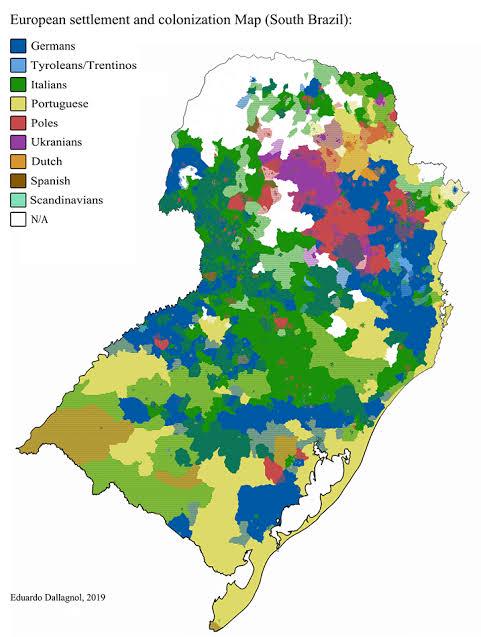Main Ethnicities in Southern Brazil Map


Alex Cartwright
Senior Cartographer & GIS Specialist
Alex Cartwright is a renowned cartographer and geographic information systems specialist with over 15 years of experience in spatial analysis and data...
Geographic Analysis
What This Map Shows
The "Main Ethnicities in Southern Brazil Map" provides a detailed overview of the diverse ethnic groups that inhabit this vibrant region of Brazil. It highlights the predominant ethnicities in each state, showcasing how historical migrations, colonization, and cultural exchanges have shaped the demographic landscape of Southern Brazil. The states represented include Paraná, Santa Catarina, and Rio Grande do Sul, each with their unique cultural fabric woven from various ethnic threads.
Deep Dive into Ethnic Diversity in Southern Brazil
Southern Brazil is a rich tapestry of ethnicities that have contributed to the cultural and social dynamics of the region. The predominant groups include European descendants, particularly those of German, Italian, and Portuguese descent, as well as Indigenous populations and Afro-Brazilian communities. This mix has created a unique cultural environment that is distinct from other parts of Brazil, where African and Indigenous influences are more pronounced.
Historically, the southern region of Brazil experienced significant European immigration in the 19th and early 20th centuries. This influx was largely driven by economic opportunities, as the fertile lands attracted settlers looking for a better life. For instance, in the state of Santa Catarina, the arrival of German immigrants in the 1820s led to the establishment of communities that still celebrate their heritage through festivals, traditional music, and culinary delights.
Interestingly, the Italian influence is most notable in the state of Rio Grande do Sul, where the Italian immigrants settled in the late 19th century. They brought with them agricultural techniques and a strong sense of community, which has transformed the region's economy and cultural practices. Today, you can find Italian-inspired cuisine and cultural celebrations, such as the Festa da Uva, which showcases the wine-making tradition that has become a staple in this area.
What's fascinating is how these ethnic groups have interacted over time. While there are distinct cultural practices, intermarriage and social integration have created a more homogenized Brazilian identity in many areas. This blending of cultures is evident in the region's festivals, music, and dialects, which reflect a fusion of influences that enrich the local culture.
However, it's important to recognize the ongoing challenges faced by Indigenous populations and Afro-Brazilian communities in Southern Brazil. Despite the significant contributions these groups have made to the cultural landscape, they often encounter issues related to land rights, social inequality, and cultural recognition. Understanding these dynamics is crucial for a holistic view of the region's ethnicities.
Regional Analysis
Breaking down the ethnic composition by state reveals interesting variations. In Paraná, for example, the population is predominantly of European descent, with significant German and Italian communities. The state's capital, Curitiba, has become a melting pot of cultures, making it a vibrant urban center that mirrors this diversity.
In contrast, Santa Catarina showcases a more pronounced German heritage, particularly in towns like Blumenau, which is famous for its Oktoberfest celebration. The German influence is evident not only in the architecture but also in the local cuisine and customs.
Moving to Rio Grande do Sul, one can observe how the Italian influence has shaped the culture significantly, especially in the northern regions of the state. Cities like Caxias do Sul reflect this heritage through their annual grape harvest festivals and Italian-themed events.
Moreover, Indigenous populations, although smaller in number compared to their European counterparts, continue to play a vital role in the cultural identity of Southern Brazil. Their traditions and languages are essential to preserving the region's history, and efforts are underway to ensure their voices are heard in the ongoing dialogue about cultural heritage and rights.
Significance and Impact
Understanding the ethnic diversity in Southern Brazil is essential for grasping the region's identity and socio-economic dynamics. This diversity not only enriches the cultural landscape but also impacts everything from local governance to economic development. For instance, festivals celebrating various ethnic heritages attract tourism, which boosts the local economy.
Furthermore, as Brazil continues to grapple with issues of race, identity, and social justice, the ethnic composition of Southern Brazil provides a microcosm of the broader national discourse. Recognizing and valuing this diversity is crucial for fostering social cohesion and promoting inclusive policies.
Looking ahead, the future of Southern Brazil’s ethnic landscape will likely be influenced by ongoing migration trends, globalization, and the resilience of Indigenous and Afro-Brazilian communities. As these groups continue to assert their identity, they will shape the region's cultural narrative, making it an exciting area to watch in the coming years.
In conclusion, the "Main Ethnicities in Southern Brazil Map" is not just a visualization of demographics; it is a testament to the complex interplay of cultures that define this dynamic region. Understanding these ethnicities helps us appreciate the rich history and vibrant future of Southern Brazil.
Visualization Details
- Published
- October 12, 2025
- Views
- 32
Comments
Loading comments...